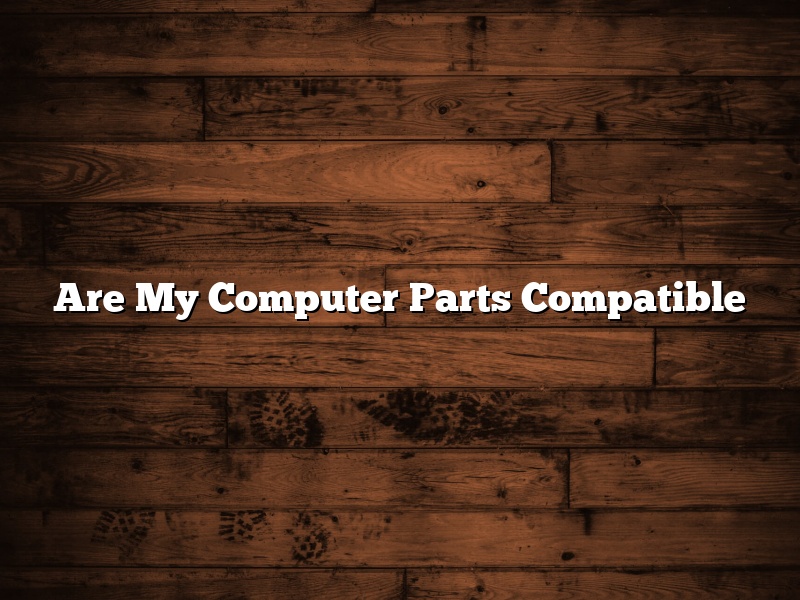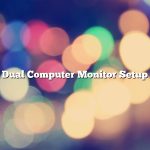Are My Computer Parts Compatible?
When building or upgrading a computer, one of the most important decisions you’ll make is what components to use. But with so many options available, it can be difficult to know if your parts will work together. In this article, we’ll help you figure out if your computer parts are compatible and provide some tips for compatibility testing.
First, let’s take a look at some of the factors that can affect compatibility.
Motherboard Compatibility
The motherboard is the central component of a computer and is responsible for connecting all of the other parts. It’s therefore essential to choose a motherboard that is compatible with the other parts you plan to use.
One of the most important factors to consider when choosing a motherboard is the type of processor it supports. For example, if you want to use an AMD processor, you’ll need a motherboard that supports AMD processors. Likewise, if you want to use an Intel processor, you’ll need a motherboard that supports Intel processors.
Another important consideration is the form factor of the motherboard. The form factor is the size and shape of the motherboard. There are three main form factors: ATX, micro-ATX, and mini-ITX. ATX is the largest form factor and can support the most components. micro-ATX is smaller than ATX and can support fewer components. mini-ITX is the smallest form factor and is generally used in small systems.
If you’re not sure which form factor your motherboard supports, check the manufacturer’s website or the motherboard’s documentation.
RAM Compatibility
RAM (random access memory) is used to store data and programs that are currently being used by the computer. When choosing RAM, you’ll need to consider the type of RAM and the number of slots on the motherboard.
The type of RAM is important because not all types of RAM are compatible with each other. For example, DDR2 RAM is not compatible with DDR3 RAM. If you’re not sure which type of RAM your motherboard supports, check the motherboard’s documentation or the manufacturer’s website.
The number of slots on the motherboard is also important. Some motherboards have two slots, while others have four or more. If you plan to use more than one stick of RAM, you’ll need a motherboard with enough slots to support your configuration.
Graphics Card Compatibility
A graphics card is a separate component that is used to generate the images that are displayed on the screen. When choosing a graphics card, you’ll need to consider the type of slot on the motherboard that it uses.
There are three main types of graphics card slots: PCI, AGP, and PCIe. PCI slots are the oldest type and are no longer used in new computers. AGP slots are also no longer used in new computers, but they are still used in some motherboards. PCIe slots are the most common type and are used in most new motherboards.
If you’re not sure which type of slot your motherboard uses, check the motherboard’s documentation or the manufacturer’s website.
Hard Drive Compatibility
A hard drive is used to store data and programs. When choosing a hard drive, you’ll need to consider the size and the type of connector.
The size of the hard drive is important because you’ll need to make sure it’s large enough to store the data and programs that you want to keep. The type of connector is important because you’ll need to make sure it’s compatible with the type of port on the motherboard.
Most hard drives use the SATA connector, but some older hard drives use the IDE connector. If you
Contents
- 1 How do you know if computer parts are compatible?
- 2 Is there a website to check if PC parts are compatible?
- 3 How do I choose compatible parts to build a computer?
- 4 Can you mix brands of PC parts?
- 5 Can you put any CPU in any motherboard?
- 6 How do I know if my motherboard and CPU are compatible?
- 7 Why are some motherboards incompatible?
How do you know if computer parts are compatible?
When it comes to computer parts, there is a lot of compatibility concerns that go into it. It is important to make sure that all of the parts in your computer are compatible with each other, lest you run into any problems. In this article, we are going to take a look at some of the ways that you can determine if computer parts are compatible with each other.
One of the most common ways to determine if computer parts are compatible is by checking the part numbers. Most parts will come with a part number, and you can use this number to cross-reference compatibility on the manufacturer’s website. If the part numbers match, then the parts are likely compatible.
Another way to check for compatibility is by looking at the physical size of the parts. This is especially important for cases and motherboards. Cases and motherboards will usually have specific sizes that they will fit, and you need to make sure that the parts you are using will fit into the case and motherboard.
One of the last ways to check for compatibility is by checking the power requirements of the parts. Each part in a computer will have a certain wattage requirement, and you need to make sure that the power supply in your computer can handle the load. If the power supply is not powerful enough, then the parts will not work correctly.
So, those are some of the ways that you can check for compatibility between computer parts. Keep these tips in mind the next time you are building or upgrading a computer, and you should be able to avoid any compatibility issues.
Is there a website to check if PC parts are compatible?
Is there a website to check if PC parts are compatible?
There are a few different websites that can help you check if PC parts are compatible. One of the most popular websites for compatibility checking is PCPartPicker. This website allows you to search for parts that are compatible with each other and also offers a compatibility checker tool.
Another website that offers compatibility checking is cpubenchmark.net. This website allows you to search for parts by Socket type, Processor type, and Motherboard type. It also offers a compatibility checker tool.
Finally, the last website that offers compatibility checking is cpu-world.com. This website offers a database of CPUs, Chipsets, and Motherboards. It also offers a compatibility checker tool.
How do I choose compatible parts to build a computer?
When assembling or building a computer, it is important to choose compatible parts. This means ensuring that all the components of the system will work well together. In order to do this, you need to understand the different components of a computer and what each one does.
The motherboard is the main circuit board in a computer. It is responsible for the communication between all the different parts of the system. The CPU, or central processing unit, is the brain of the computer. It is responsible for executing the instructions of the software. The RAM, or random access memory, is used to store data temporarily. The hard drive is where all the data is permanently stored.
When choosing compatible parts, it is important to make sure that the motherboard has the correct socket type for the CPU and that the RAM is compatible with the motherboard. The hard drive and other components can usually be chosen based on their compatibility with the motherboard.
It is also important to make sure that the power supply is powerful enough to handle the components of the system. The power supply is responsible for delivering power to the different parts of the computer.
When choosing a case for the computer, it is important to make sure that it is large enough to accommodate all the components. The case also needs to have the correct number of slots and connectors for the motherboard, CPU, RAM, and hard drive.
The most important part of choosing compatible parts is ensuring that the components are all compatible with each other. By following these tips, you can ensure that your computer will be up and running in no time.
Can you mix brands of PC parts?
Can you mix brands of PC parts?
The short answer is yes, you can mix brands of PC parts. However, there are a few things you need to take into consideration before doing so.
One of the biggest things to consider is compatibility. Make sure that the different brands of parts you’re using are compatible with each other. Generally, brands that are made by the same company are compatible with each other. For example, you can usually mix different brands of motherboards, CPUs, and memory, but you may not be able to mix different brands of video cards.
Another thing to consider is warranty. If you mix brands of PC parts, your warranty may be invalidated. So, before mixing brands, make sure you’re aware of the warranty implications.
Finally, mixing brands of PC parts can sometimes lead to compatibility issues. So, if you’re having problems getting your computer to work, it may be worth trying to swap out some of the parts for brand-name parts.
Can you put any CPU in any motherboard?
One of the great things about the current state of the computer industry is that the hardware is incredibly standardized. This means that, in most cases, you can put any component into any compatible chassis or motherboard.
This standardization extends to the central processing unit (CPU) and the motherboard. In most cases, you can put any CPU into any motherboard. However, there are a few caveats.
The first is that the CPU and motherboard must be of the same type. For example, you cannot put an Intel CPU into a motherboard that uses a AMD processor.
The other consideration is that the CPU and motherboard must be of the same generation. So, you cannot put a first-generation Intel CPU into a motherboard that uses a sixth-generation Intel chipset.
Beyond those two considerations, you can put any CPU into any motherboard. This allows you to choose the best CPU for your needs, without being constrained by the motherboard.
For example, if you need a high-powered CPU for gaming or video editing, you can choose the best option available, regardless of the motherboard. This flexibility also allows you to upgrade your CPU without having to upgrade your motherboard.
So, can you put any CPU in any motherboard? The answer is yes, with a few caveats. For the most part, however, the hardware is standardized, so you can choose the best components for your needs.
How do I know if my motherboard and CPU are compatible?
If you’re in the market for a new CPU, one of the biggest decisions you’ll need to make is whether your motherboard is compatible. CPUs come in different sizes and shapes, and your motherboard needs to have a socket that matches your CPU in order to work.
Socket type is indicated on the motherboard, and also on the CPU itself. You can find both of these markings on the top of the CPU. The socket type will be either LGA (Land Grid Array), or PGA (Pin Grid Array).
To check if your motherboard is compatible with a certain CPU, you can use the CPU support list on the motherboard manufacturer’s website. This list will tell you which CPUs are compatible with your motherboard.
If you’re not sure which motherboard you have, you can find the motherboard’s model number and serial number by opening the computer case. The model number will be on a sticker on the motherboard, and the serial number will be on a sticker on the power supply. You can then use these numbers to search for the motherboard’s specifications on the manufacturer’s website.
It’s also a good idea to check the CPU cooler compatibility. Not all coolers are compatible with all CPUs. The cooler compatibility list can also be found on the motherboard manufacturer’s website.
If you’re still not sure if your motherboard and CPU are compatible, you can always contact the motherboard manufacturer or the CPU manufacturer for more information.
Why are some motherboards incompatible?
Motherboards are one of the most important computer components, and as such, it is important to make sure that you are choosing the right one for your needs. In some cases, however, motherboards are incompatible with each other, which can cause all sorts of problems. So, why are some motherboards incompatible?
The reason for this is that motherboards use different sockets to connect to the processor. There are a number of different sockets, but the two most common are the LGA 1151 and LGA 1150 sockets. If the motherboard and processor use different sockets, then they will be incompatible.
Another reason for incompatibility is that some motherboards only support certain processors. For example, some motherboards only support the Intel Core i3, i5, and i7 processors, while others only support the AMD A-series and FX processors. If you have a processor that is not supported by the motherboard, then they will be incompatible.
Some motherboards also have different features, which can also lead to incompatibility. For example, some motherboards have different numbers of ports, or different types of ports. If the motherboard has different ports than the processor, they will be incompatible.
Finally, some motherboards are just not compatible with certain operating systems. For example, some motherboards are not compatible with Windows 10, while others are not compatible with Mac OS. If you have a motherboard that is not compatible with the operating system that you are using, then they will be incompatible.
So, if you are having problems with your computer and you are not sure why, it is worth checking to see if the motherboard is incompatible with the processor or the operating system. If it is, then you will need to replace either the motherboard or the processor, or the operating system, in order to fix the problem.




